


An early pioneer of compound Steam Engines.....
From steam ship to four-masted barque....
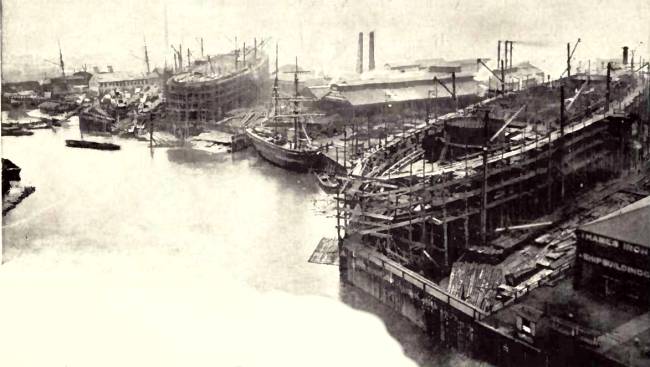
The Thames Ironworks & Shipbuilding Company, c 1860
The first ship to bear the proud name ' Mooltan' was built for P&O by the Thames Ironworks and Shipbuilding Company at their Bow Creek, London yard. She was launched by the wife of Captain W.H.Hall RN, a P&O director.
.gif)
ss Himalaya. Source: Illustrated London News c1860
The company, then named C.J.Mare and Co, had built P&O's ss Himalaya in 1853, later sold to the Royal Navy for £130,000.
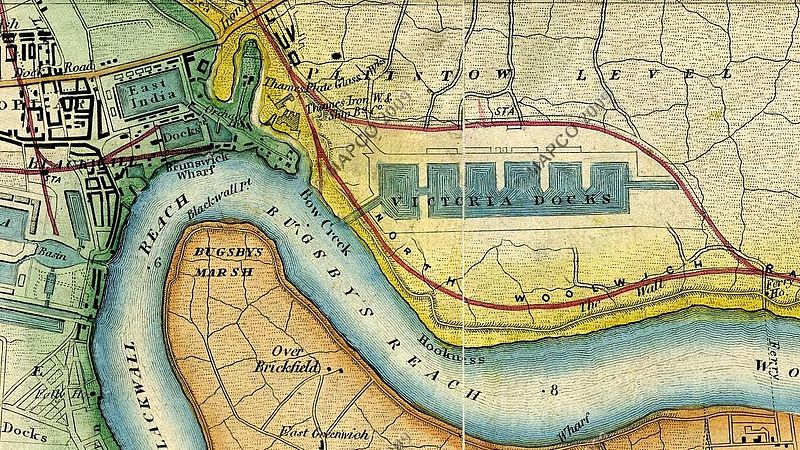
Map showing part of the River Thames and The Thames Ironworks & Shipbuilding Company, at Bow Creek. Source: Wyld's New Topographical Map Of The Country In The Vicinity Of London c 1872.
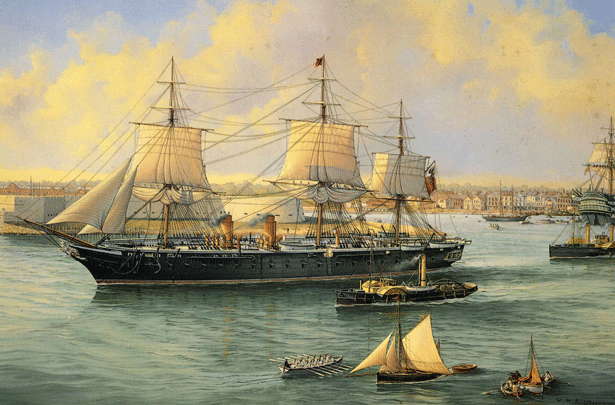
Built at The Thames Ironworks & Shipbuilding Company and launched in 1860, the frigate HMS Warrior, was the Royal navy's first armour-plated iron hulled warship.
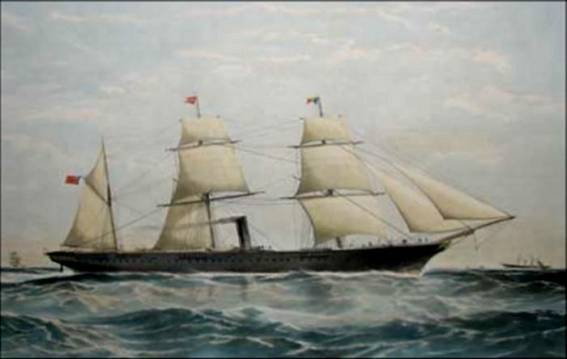
P&O's elegant steamship Mooltan, iron hulled and rigged for sail. Lithograph by Thomas Goldsworth Dutton (c.1819-1891)
Note: Thomas G. Dutton is considered not only the finest nineteenth century lithographer - but also one of the most prolific - in recording shipping and shipping scenes. He is also a noted watercolourist and oil painter. He is most widely recognized for his lithographs, yet his excellent marine paintings are also widely collected when they can be found. Original works by T.G. Dutton are considered today quite rare. His paintings of clipper ships, created generally for his lithographs were quite popular in his era. Today, they are seldom seen outside of the lithographs that still survive.
Ship's Particulars of the ss Mooltan of 1861
Tonnage: 2,257 grt ~ 1,627 nrt
Dimensions: 349ft length x 39.1ft beam x 28.7 ft draught
Engines: 1,734 iHP, built by Humphreys & Tennant of Deptford.
Type: Tandem Compound Inverted Direct-Acting Steam Engines to Wolf Esq.'s design.
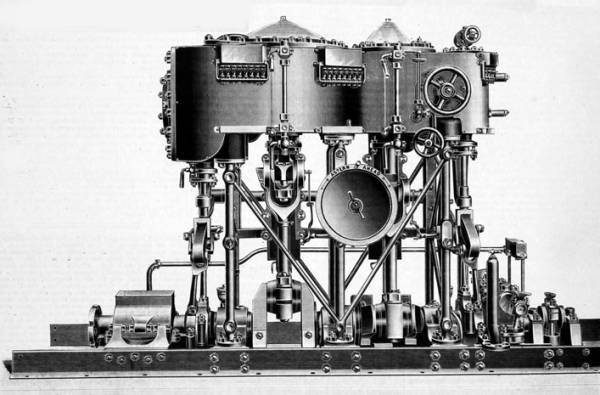
The P&O company's first compound engine. Picture Source: Grace's Guide
Single screw.
Designed Service Speed: 12.0 knots.
Ship Design: Iron Hull, Clipper bows, single funnel, three masts (rigged for sail)
Passenger Capacity: 112 First Class + 37 Second Class
Date of First Registry: 8th March 1861
On her initial sea trials, she 'jumped and rocked', without achieving her designed speed of 12 knots.
She was unusually long for her beam, with a length-to-breadth ratio of around nine.
Unfortunately for the Company, her engines, which were designed to significantly reduce coal consumption, proved unreliable - and frequently broke down. Consequently, in 1866, new engine and boilers were installed, by C A Day of Southampton.
From 'The Times' – 27th November 1861
Southampton, Tuesday. This vessel, respecting the performances of which on an ocean voyage, great interest has been felt in nautical and engineering circles, returned to this port last night from Alexandria. One of the most novel features is the smallness of her horse power as compared with her tonnage, and the reduced size of her boilers, which are constructed on Mr. A. Lamb's patent, and which are only about half the size of the tubular boilers employed in ships of the Royal Navy for the supply of steam to engines of the same nominal horse-power. The effect of the principle adopted in the Mooltan, if successful, will be to materially reduce the consumption of coal, and hence to lessen the expenses and difficulties attendant upon ocean steam navigation. It appears that the most remarkable and successful results have been accomplished in this respect during the recent voyage of the Mooltan to and from Alexandria. On the outward voyage she was 286 hours under way, running 2,951 miles, with an actual consumption of 305 tons of coal and coming home she was 236 hours under way, consuming 325 tons of coal. The total quantity of coal consumed, therefore, during a voyage of nearly 6,000 miles. has been 630 tons, against an expenditure of about 1,200 tons in other ships of the same tonnage employed on this line. This is a saving of very nearly half, while an average speed has been maintained out and home of 10.64 knots.
The average expenditure of coal per hour was 2,574 lb, and the average power taken by the indicator, every watch, 1,230 horses. During the voyage the Mooltan's draught of water was 19ft. 4in; average midship section at this draught, 558 ft; and average displacement at same, 3,335 tons. The boilers supplied abundance of steam at 20 lb; surface condensers, average vacuum, 27.5 inches. These results must be very satisfactory to her engine-builders, Messrs. Humphrys and Tennant, and to the patentee of her boilers, and all others concerned, while they are of vast importance to every one interested in steamships. It is important to observe that these results have been obtained, over a run of nearly 6,000 miles, with the
ordinary coal used by all the company's steamers, and with the ship's own stokers; and hence they should not be compared with those obtained at the trial of a ship at the measured mile, or on a few hours working of her engines at moorings, because these short trials are always made under the most favourable circumstances, with picked coal of the best quality, clean fires, and stokers of the greatest skill.
From 'The Engineer' - 18th October 1861
The Peninsular and Oriental Company's screw steamer Mooltan left Southampton Docks on Monday morning, and was taken to the measured mile in Stokes Bay for an official trial of her speed, it having been considered by the Post Office authorities that when previously tried she was not sufficiently immersed in the water to meet the requirements of the company's postal contract. Hence on this occasion she was loaded to 20ft. mean draught, being nearly a foot in excess of any vessel belonging to this company previously tried at the mile. At 20ft. draught her displacement is 3,508 tons, and her midship section 518ft. These figures represent the important measures of the resistance of a ship, and as both these are in excess of the same elements in the Himalaya, which vessel is fitted with engines of 700 nominal horse-power, much doubt was entertained and expressed as to the possibility of the 400 horse power engines of the Mooltan driving her 12 knots. The result, however, of the trial on Monday has dispelled all conjecture on this point, the ship having realised 12 knots with ease. It is to be borne in mind, however, that the Himalaya on her trial trip, and t when displacing 3,260 tons, and having an area of immersed midship section of 556.6 square feet, attained a speed of 13.9 knots with 2,050 indicated horse-power. The difference between the resistances of vessels at different speed varies as the cubes of their speeds, and hence a speed of 13.9 knots requires 55 per cent more power for its attainment than a speed of 12 knots, at which latter speed the , Himalaya, with the same displacement and immersed mid-section, as before, should have been expected to run with 1,820 indicated horse-power. The indicated power of the Mooltan on the late trial is not given, but probably amounted to 1,600, if not 1,800 horse power, and considering the superior form of the vessel, the result is hardly what might have been expected. Any comparison of the nominal power of the Himalaya and Mooltan would be quite irrelevant, inasmuch as in one case the engines work up to three times and in the other to four or four and-a-half , times the nominal power.
The Times, in a notice of the Mooltan's trial trip, dwells upon the merits of Lamb's boilers as follows:- " But the most remarkable feature in the Mooltan is the fact that , her boilers, made on Mr. Lamb's patent principle, which supplied an abundance of steam, are only about half the size of the tubular boilers in the Royal Navy employed to supply steam for engines of the same nominal power."
When, however, it is considered that Mr. Lamb's boiler evaporates no more water for a given weight of coal than any other boiler, the "remarkable feature" disappears. The patent principle " of the boiler has, in fact nothing to do with the performance of the engines, whether they be good or bad. The simple fact is that the engines have surface condensers, the only ones in the Peninsular and Oriental Company's fleet (these condensers, at the same time being, mechanically, much inferior to other surface condensers in use). Thus, pure distilled water is constantly supplied to the boilers, the necessity for blowing-off is obviated, and a given quantity of steam can lie produced, therefore, with smaller boilers than would otherwise be necessary, and the "principle" of the boilers, whether patented or unpatented, has nothing to do with the economy. So, too, the Mooltan has her steam cylinders jacketted, and the steam is worked to a much higher degree of expansion than in any other vessel in the company or in the navy. Thus a given weight of steam goes further than in other vessels." It is unfair, however, to claim, as has been done, the credit of this mode of working the steam for either Mr. Lamb's boiler, or Messrs. Lamb and Summers' superheaters, both of which claims have been set up in the Times, and in other journals guiltless of the least knowledge of engineering.
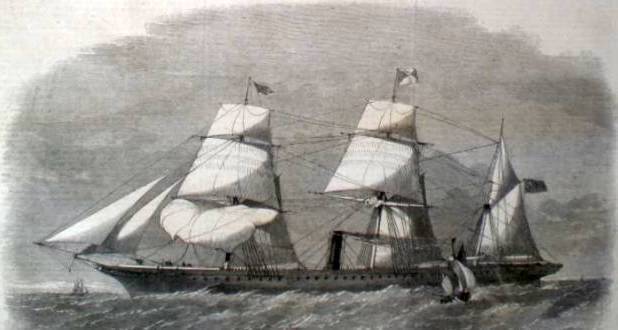
ss Mooltan - From The Illustrated London News of 1861
Mooltan's maiden voyage commenced at Southampton on 20th July 1861, before completion of the Suez Canal, (opened in November 1869) taking to her Alexandria in Egypt. In late 1862, she was transferred to the Suez to Calcutta route, and in 1873, was transferred to Company's Bombay - Sydney service.
MOOLTAN, 610 tons, sailed from Greenock on 11/9/1849, and arrived at Port Chalmers on 26/12/1849. Captain William Chivas; Dr William Purdie, surgeon.
End of Days
On 15th November 1874 she was withdrawn from service and laid up in London.
On 14th December 1880, she was sold to Messrs Elles & Co of Liverpool.
In 1883 she was sold to J. J. Wallace of London.
In 1884 she was sold again, this time to J. Pedley of London, renamed Eleanor Margaret and converted to a four masted barque.
In 1888 she was sold to J. D. Bischoff of Bremen, Germany.
On 28th June 1891, she sailed from Newcastle-upon-Tyne for Valparaiso, only to be reported missing in the North Atlantic. 'Last spoken' at 45°N, 25°W.
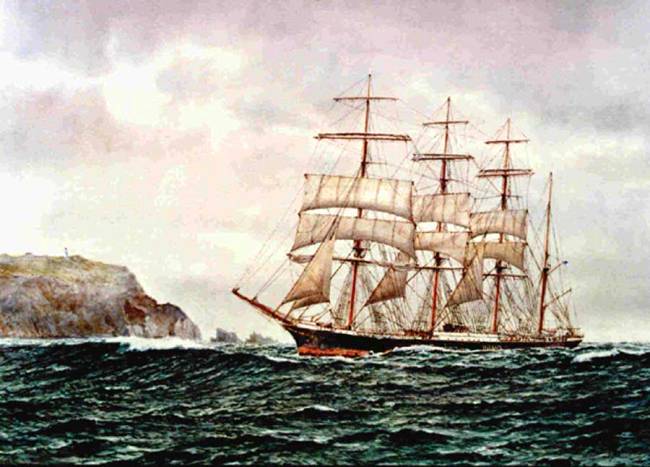
From The Sydney Morning Herald - 24th December 1888
“After a somewhat smart passage of 92 days the four-masted ship Eleanor Margaret arrived in port from London with a full general cargo. She has under hatches between four and five thousand tons 'of weight' and measurement goods, which is one of the largest cargoes that has ever arrived in Sydney in one bottom. Those who remember the P. and 0. Company's Mooltan would scarcely recognise her now in her new rig, that of a four-master. It was in 1894 that the Mooltan was stripped of her engines and boilers, and fitted out as a sailing vessel. Since being converted into sailing vessel she has changed hands twice, and she now flies the German flag, and is owned by Mr. J.D.Bishop - (J D Bischoff) The Eleanor Margaret is a fine specimen of naval architecture. She has a very fine entrance, with a good turn aft, and should prove a fast goer. She is 948ft, long and 2,327 tons net register. Captain Fischer reports having left London on September 22; N.E. winds were experienced down Channel followed by calms and S.E. winds to the NE trades, found in 40 north. They proved good and fresh and gave out in 17 north. Southerly and S.W. winds followed, The equator was crossed on October 30 in 26 west. The S.E. trades were only light and failed in 20 south. Variable winds ensued when off the Cape of Good Hope. Encountered a very heavy gale, which veered from the N.W. to S.E., the ship laboured considerably, and shipped some heavy water which filled her up to the rail. All movables were washed adrift and overboard, and some slight damage was also sustained. Two topsails, one jib, and the foretopgallant staysail were lost in the blow. Captain Fischer ran his easting down on the parallels of 45 to 47 south ; light north-westerly winds were experienced. The Eleanor Margaret made the coast off the Otway on the 19th instant. She came through the Straits with fair winds. She was towed in, and brought up in Neutral Bay. A Nova Scotia barque, bound from Iquique to Falmouth, was supplied with a few stores and provisions by the Eleanor Margaret just before the latter made the Cape of Good Hope."
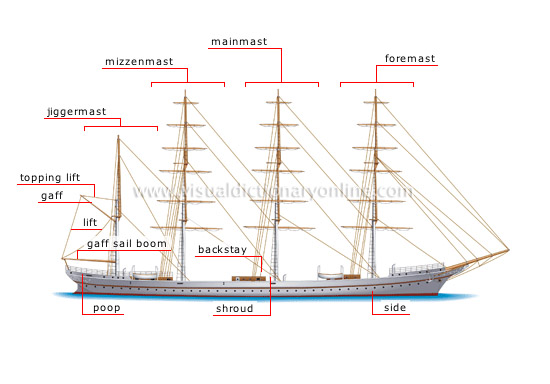
A Selection of Mooltan Miscellanea
"When the P. & O. liner Mooltan sails on her next voyage to Australia in April she will have on display in one of the public rooms an attractive coloured lithograph of the first Mooltan of 1861. It has been presented to the company by Mr. W. H. Dunn, of Wimbledon, whose father, Capt. George Dunn, commanded the vessel from 1862 to 1864.
The first Mooltan, which was then one of the crack ships of the company's fleet, had a tonnage of 2,257.and her inverted tandem compound engines-she was the first vessel of the line to have that complicated system of power-developed 1,734 horsepower. As she burned about 630 tons of coal on her first voyage, against 1,200 by a consort of older design, she was deemed a success.
When he joined the company in 1855 Capt. Dunn was appointed chief officer of the Colombo. He saw active service in the Crimean War when that ship carried troops and stores from Britain.. He was sent by the overland Suez route to Calcutta in 1856 to become chief officer of the Bengal and later the Simla, receiving promotion to commander on appointment to his old ship, Colombo, in 1860.
Mr. Dunn possesses his father's diploma and insignia of the Order of Charles III, of Spain, granted by Queen Isabel in return for valued services while he was in command of the Colombo in 1860." Source: Port Pirie Recorder 14th March 1949
![]()
"The Peninsular and Oriental Company's steamship Mooltan, with the Australian mails, broke down thrice en route to Malta. The mails were transhipped on board the Delta. A supplementary mail was, in consequence of the delay, forwarded from London, dated the 3rd of August." Source: The Maitland Mercury 19th September 1861
![]()
"Hippisley Cox, born 1849 became a mariner. He first served as an apprentice aboard the barque Haddington from 26th May 1864 to 12th November 1867 and then served as fifth mate aboard the S.S. Carnatic, a ship run by the Peninsular & Orient Steam Navigation Company, from 12th November 1867 to 29th January 1868. He served as fourth mate about the P&O ships S.S. Malta and S.S. Bengal, from 18th July 1868 to 15th July 1870, and was then appointed third mate while serving about the S.S. Poonah from 28th November 1870 to 16th June 1873. He served as third mate aboard the P&O ships S.S. Mooltan and S.S. Hindustan from 16th June 1873 to 9th May 1874, before joining the Pacific Steam Navigation Company. He was granted his Master's certificate on 25th March 1880 ."
![]()
"The invention of the compound steam engine dramatically reduced the cost of shipping goods by sea, and, at the same time, the shortening of the sea route to India, coupled with inauguration of submarine cable links, helped to accelerate the growth of commerce. From 1880 refrigeration began to make it practicable to ship beef, lamb, butter, and fruit halfway around the globe.
Worldwide trade ballooned in the second half of the nineteenth century, and the opening of the Suez Canal in 1869 had the effect of channeling much of the resultant shipping through the Middle East. Britain had become embraced in an economic partnership with India which imbued every aspect of national life: industrial, social, military, cultural, and scientific. England, without India, was unthinkable, and the essential connection was an uninterrupted procession of steamships passing through the Canal.
In the days of sail, if you went to work for the East India Company you could expect to return home perhaps once before retirement; it was customary to grant a three-year furlough in mid-career. The voyage from England to India via the Cape of Good Hope took six months at least, and you might have another three or four months of traveling to do before reaching your final destination. Replies to letters, therefore, could well take over a year and a half to receive.
The technology of steam was the driving force behind the Industrial Revolution, and it was the introduction of steam propulsion that made possible regular transit of the Red Sea. Early steamers were grossly uneconomical; they were used first, therefore, in situations where passage under sail was most severely handicapped, as on canals, rivers, and lakes. The Red Sea is narrow, with treacherous shoals along its eastern shore, and prevailing winds blow in opposite directions in the northern half and in the south. It was not practical to operate from end-to-end on a regular basis under sail.
Before 1830 passengers bound for the East had no alternative to circumnavigating Africa. In that year the East India Company pioneered the Red Sea route with a small steamer, built in India, called the Hugh Lindsay. From 1835 the mails for India were sent through the Middle East rather than around the Cape, and in 1837, the Company started a steam packet service between Bombay and Suez with the paddlers Berenice and Atalanta. These early steamers were not equal to the task of maintaining their timetables throughout the monsoon, but the average journey time from India to Britain was reduced from six months to two.
The connection across the Middle East was suitable only for passengers and mail. There was an awkward trip by horse-drawn wagon 84 miles across the desert from Suez to Cairo, down the Nile in the Jack O'Lantern, a tiny paddle steamer, and then transit by barge on the Mahmoudieh Canal to the Mediterranean port of Alexandria. In 1840 the Peninsular and Oriental Steam Navigation Company won a contract to take over the packet service from there to England, hitherto run by the Admiralty. The whole journey was first described as the Steam Route; later, and more generally, it became known as the Overland Route.
Within three more years, P & O opened a regular steamer service from Suez to Calcutta via Ceylon and Madras. The obstacles were considerable: steam coal from South Wales had to be shipped to the Indian Ocean via the Cape, and by the 1850s, P & O alone employed some 170 sailing colliers for the purpose. Coal was stocked at Aden, roughly midway on the 3,000-mile voyage between Suez and Bombay; up to a third of the journey time was taken up in coaling ship.
A herd of 3,500 camels was employed in humping coal across the desert. The beasts were superseded in 1858 when the newly opened railway connecting Alexandria with Suez presented an alternative. From: Passage East by Ian Marshall, The Howell Press 1997.
![]()
The Thames Ironworks & Shipbuilding Company
1898-1901: 4 first-class battleships were being built at the same time - the HMS Albion, HMS Cornwallis, and HMS Duncan for the Royal Navy and the Japanese battleship Shikishima were launched between 1898 and 1901. But the yard was increasingly uncompetitive with competitors in the North East and Scotland, and the cramped nature of the location presented problems for launching and fitting-out. After 1901 the yard only received 3 Admiralty contracts. 1904: The cruiser HMS Black Prince was launched.
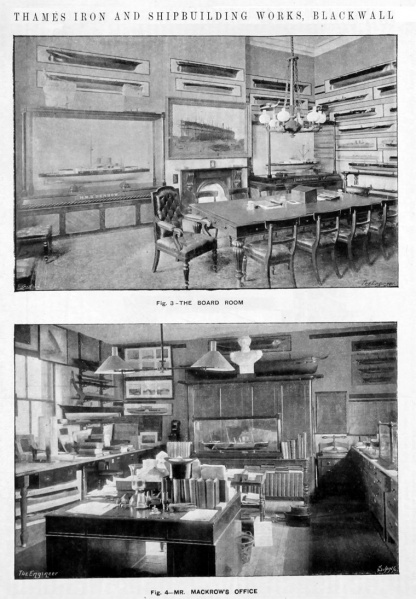
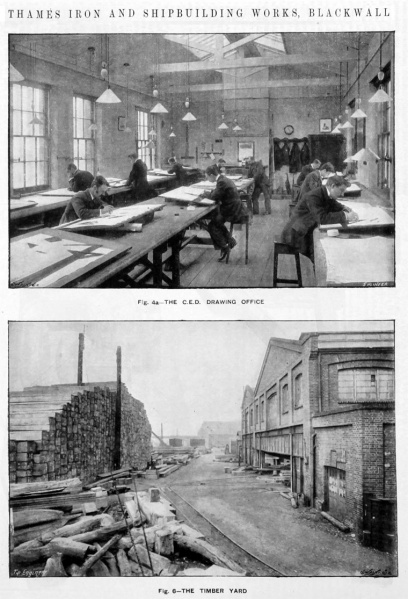
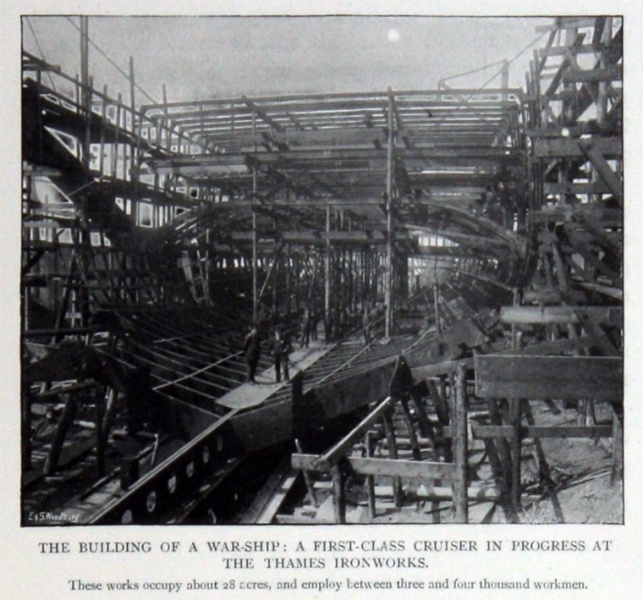
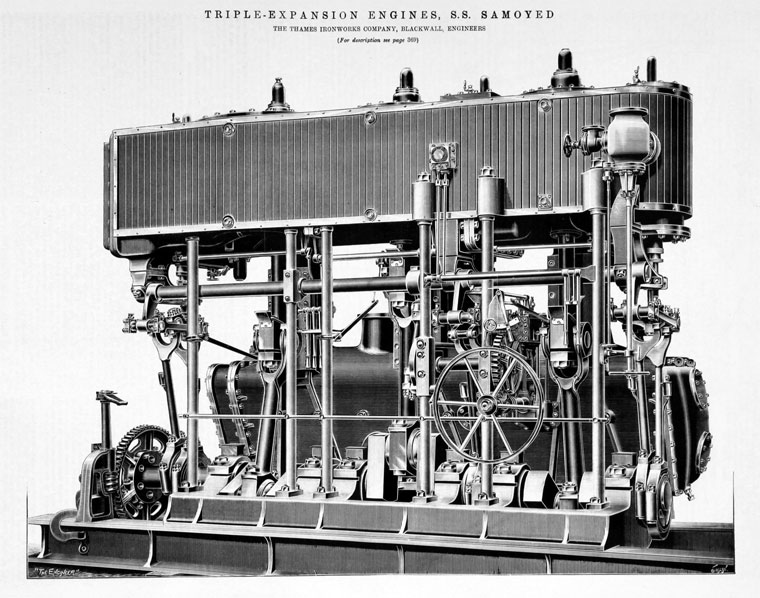
Picture Source: Grace's Guide-British Industrial History
1910:Advert for motorcars: full details of all models available from Thames Engineering Co Motor Dept, Greenwich. Made under the trade name Thames at the Blackheath engine works.
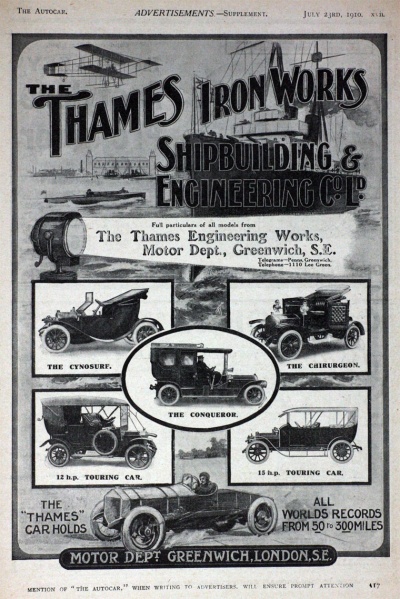
1911: Launched the Dreadnought battleship HMS Thunderer, the last and largest ship constructed by the firm. The ship was produced efficiently and on time but a special wharf had to be hired at Dagenham to fit her out as there was no room in the shipyard.
No further orders were forthcoming
In 1912, the shipyard closed.